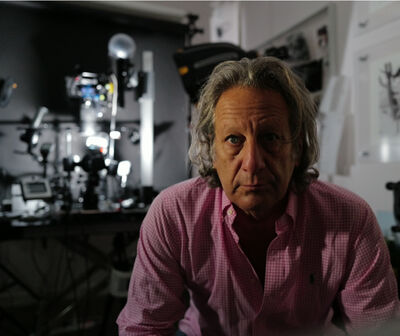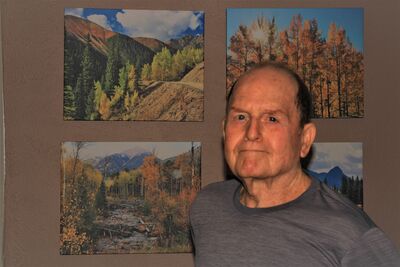Natural light...all the time...every location
May 5, 2023 08:52:15 #
Checkout a book, 'Capturing Light' by Michael Freeman. He discusses many 'types' of natural light with examples of photos he captured with the light.
May 5, 2023 08:53:40 #
Bubbee wrote:
I disagree! Thomas has been very helpful and encouraging to me! No offense, but I think you may have misunderstood his reply.
He is one of the best here...show him your work and he will help! My advice...get a mirrorless (Z) which works great n low light!
He is one of the best here...show him your work and he will help! My advice...get a mirrorless (Z) which works great n low light!
Thank you. I may have misinterpreted Thomas’ message. It just struck me as a bit didactic to a first time poster and new member of our forum. I’m not arguing the value Thomas adds, I value his contributions. I felt that his approach was a bit too harsh for this new member who has never broken any rules.
May 5, 2023 09:03:16 #
DaveyDitzer
Loc: Western PA
RobinRedbreast wrote:
I thrive on using natural light all the time. But sometimes the challenges ... very little or no light. Yep no light. I would love to hear experiences....good and bad...but most important incite into how to effectively use and capitalize on natural light.
Thanks
Thanks
I remember a Nikon rep discussing this. He called it "available darkness".
May 5, 2023 09:14:25 #
Picture Taker
Loc: Michigan Thumb
I never thought about shooting in "natural light", I have been shooting with out a flash for 70+ years, so I guess I shoot with natural light and not defined it. Thanks for calling it to my attention.
May 5, 2023 10:03:56 #
By no light do you mean total darkness? Total darkness is pretty good for night sky photography. I do not shoot the night sky often.
As has already been mentioned modern cameras do an excellent job in low light and there are excellent denoise softwares to reduce or eliminate noise.
Using flash to fill the shadows and reduce contrast is an old technique. If flash is used wisely many images can be saved in low light without resorting to high ISO settings. I am guilty of not using flash when I should and lazy enough that very often I do not carry one with me.
In regard to natural light that is what most of us use but understand that that light is most beautiful early in the morning and late in the evening when the contrast is low. During the summer months that natural light is loaded with UV rays requiring a color correction due to the blue cast on the majority of the images. I do not use UV filters but I assume they could be useful under those conditions. NEVER forget to clean the lens and the filter before you begin shooting.
As has already been mentioned modern cameras do an excellent job in low light and there are excellent denoise softwares to reduce or eliminate noise.
Using flash to fill the shadows and reduce contrast is an old technique. If flash is used wisely many images can be saved in low light without resorting to high ISO settings. I am guilty of not using flash when I should and lazy enough that very often I do not carry one with me.
In regard to natural light that is what most of us use but understand that that light is most beautiful early in the morning and late in the evening when the contrast is low. During the summer months that natural light is loaded with UV rays requiring a color correction due to the blue cast on the majority of the images. I do not use UV filters but I assume they could be useful under those conditions. NEVER forget to clean the lens and the filter before you begin shooting.
May 5, 2023 10:41:59 #
May 5, 2023 12:00:27 #
Robertl594 wrote:
Thank you. I may have misinterpreted Thomas’ message. It just struck me as a bit didactic to a first time poster and new member of our forum. I’m not arguing the value Thomas adds, I value his contributions. I felt that his approach was a bit too harsh for this new member who has never broken any rules.
I understand...We both meant well!
May 5, 2023 12:17:22 #
s_shapirstein1 wrote:
I am WITH YOU 100%!!!!!
Welcome to UHH
I’m sorry, but we don’t know who you are 100% with. If you click the Quote Reply button when responding to someone the comments you are responding to will be included in your post to give context to your reply.
May 5, 2023 13:30:13 #
Thomas902 wrote:
Welcome to UHH RobinRedbreast... br Best Advice? ... (show quote)
Thanks to you Thomas, I now know the definition of "OP". Been here for years, and understood it in general, but always wondered if I really did. Also, thanks for your usual informed response and excellent, relevant photo examples.
May 5, 2023 15:35:28 #
SO STOP FIGHTING ALREADY  Help out the new member!
Help out the new member!
There is light and lighting. First, you need to get the terminology down- it can be confusing and overlapping.
Obviously, you need LIGHT to make any kind of photographic image "Light- photos" is the name of the medium.
Available light simply means us the light that exists at the time and place you are shooting- some say "existing light". You are not adding or depending on artificial light such as s flash, tungsten, LEDor other traditional photographic light sources. It's it-is-what-it -s lighting. You may need to augment it, fill shadows, or leave it as is and apply various exposure and post-processing strategies.
There is LIGHT VOLUME- in layman's terms which can be LOW, adequate, or HIGH. In technical terms, light is measured by foot candles, lumens, etc.
In the olden old days of film photography low light was more problematic. Fast lenses, faster films, and push processing were some of the approaches. Oftentimes the results suffered from coarse grain, lack of shadow detail, insufficient depth of field or blur due to wide apertures, and slow shutter speeds. Nowadays, in digital imaging, we can employ higher IOS settings without too much excessive noise (grain), shoot with hand-held cameras at moderately high shutter speeds, stop down a bit more in low light, and employ high dynamic range settings in post-processing.
Shooting with regular equipment in total darkness is relegated to inferred and other special techniques.
"Natural Light" refers to various levels of daylight, weather conditions, and variation based on the time of day; bright sunlight, cloudy/bright, overcast, open shade, skylight, or sunlight entering through a skylight or window.
"Lighting" for me pertains to aesthetics of light- direction, harshness/softness.diffusion, and color temperature based on time of day or artificial light source.
Therefore When you inquire about "low light" etc, what's your issue- exposure, depth of field, noise, contrast, ISO settings, artistic aspects such as moods, effects, etc?
When you inquire about "low light" etc, what's your issue- exposure, depth of field, noise, contrast, ISO settings, artistic aspects such as moods, effects, etc?
Mention what you are shooting, what kind of gear you are using, and what result you are trying to achieve.
Obviously, for example, shooting sports action, portraits, landscapes, macro, birds, photojournalism, etc are each going to require different approaches and techniques.
 Help out the new member!
Help out the new member!There is light and lighting. First, you need to get the terminology down- it can be confusing and overlapping.
Obviously, you need LIGHT to make any kind of photographic image "Light- photos" is the name of the medium.
Available light simply means us the light that exists at the time and place you are shooting- some say "existing light". You are not adding or depending on artificial light such as s flash, tungsten, LEDor other traditional photographic light sources. It's it-is-what-it -s lighting. You may need to augment it, fill shadows, or leave it as is and apply various exposure and post-processing strategies.
There is LIGHT VOLUME- in layman's terms which can be LOW, adequate, or HIGH. In technical terms, light is measured by foot candles, lumens, etc.
In the olden old days of film photography low light was more problematic. Fast lenses, faster films, and push processing were some of the approaches. Oftentimes the results suffered from coarse grain, lack of shadow detail, insufficient depth of field or blur due to wide apertures, and slow shutter speeds. Nowadays, in digital imaging, we can employ higher IOS settings without too much excessive noise (grain), shoot with hand-held cameras at moderately high shutter speeds, stop down a bit more in low light, and employ high dynamic range settings in post-processing.
Shooting with regular equipment in total darkness is relegated to inferred and other special techniques.
"Natural Light" refers to various levels of daylight, weather conditions, and variation based on the time of day; bright sunlight, cloudy/bright, overcast, open shade, skylight, or sunlight entering through a skylight or window.
"Lighting" for me pertains to aesthetics of light- direction, harshness/softness.diffusion, and color temperature based on time of day or artificial light source.
Therefore
 When you inquire about "low light" etc, what's your issue- exposure, depth of field, noise, contrast, ISO settings, artistic aspects such as moods, effects, etc?
When you inquire about "low light" etc, what's your issue- exposure, depth of field, noise, contrast, ISO settings, artistic aspects such as moods, effects, etc? Mention what you are shooting, what kind of gear you are using, and what result you are trying to achieve.
Obviously, for example, shooting sports action, portraits, landscapes, macro, birds, photojournalism, etc are each going to require different approaches and techniques.
May 5, 2023 16:08:56 #
Alright, everyone step back and have a Natural Light (but not a Bud Light) and relax. The OP asked a question looking for advice, that's all.
May 5, 2023 16:42:20 #
camerapapi wrote:
By no light do you mean total darkness? Total darkness is pretty good for night sky photography...
<Geek>
Total darkness does not exist. There is ALWAYS some light. Maybe not much but some. And did you know that the photographer gives off light? The camera too. It's in the far IR so you can't see it by eye but it is still light. The only way to get total darkness is to go to absolute zero temperature.
PS: The coldest temperature ever achieved was 0.00000000000038 degrees K, in 2021. Still not zero K.
</Geek>
May 5, 2023 19:38:56 #
Using the term "available light" is much less restrictive than "natural light". That way, adding light when and where I want it doesn't violate any kind of unwritten rules and makes me way more flexible. Sun, moon, stars, streetlights, or even flash or light cubes are all "available light" once I make them available.
May 5, 2023 19:47:03 #
A PS to my previous post.
One of the most important talents or skill sets or a combination of both is SEEING LIGHT. Some folks have an inborn talent or propensity that may just need a bit of development or coaching but it could be a learned skill as well.
Seeing light means being able to assess the volume, quantity, quality, and most importantly, the light's effect on the subject. This involves RECOGNITION of all of the above. Once the basic skill is mastered it will become easier to manage exposure, create dimensionality and modeling in t your images, use lighting to render detail, and texture, and impart visually emotional aspects in your work.
The science is not all that complex. Nowadays, exposure is not difficult. There are great internal and external metering systems. The important element to study is the angle of incidence and the inverse square law.
Here at UHH, there is a "Dynamics of Photographic Lighting" section. It has very little traffic and a few interesting articles that are "stuck" there for folks to read. It seems that most folks are not interested in LIGHT because they don't post the question, ideas, or images there. Regardless of all the sophisticated gear one might own, without a mastery of light usage, the most important "tool" in the box might be missing.
One of the most important talents or skill sets or a combination of both is SEEING LIGHT. Some folks have an inborn talent or propensity that may just need a bit of development or coaching but it could be a learned skill as well.
Seeing light means being able to assess the volume, quantity, quality, and most importantly, the light's effect on the subject. This involves RECOGNITION of all of the above. Once the basic skill is mastered it will become easier to manage exposure, create dimensionality and modeling in t your images, use lighting to render detail, and texture, and impart visually emotional aspects in your work.
The science is not all that complex. Nowadays, exposure is not difficult. There are great internal and external metering systems. The important element to study is the angle of incidence and the inverse square law.
Here at UHH, there is a "Dynamics of Photographic Lighting" section. It has very little traffic and a few interesting articles that are "stuck" there for folks to read. It seems that most folks are not interested in LIGHT because they don't post the question, ideas, or images there. Regardless of all the sophisticated gear one might own, without a mastery of light usage, the most important "tool" in the box might be missing.
May 5, 2023 19:55:38 #
If you want to reply, then register here. Registration is free and your account is created instantly, so you can post right away.








